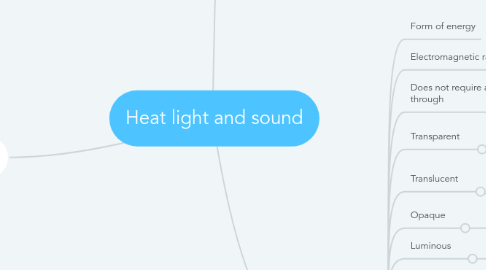
1. Sound
1.1. Waves
1.1.1. Transverse
1.1.1.1. Light, radiated heat energy
1.1.1.2. Wavelength
1.1.1.3. Trough
1.1.1.4. Crest
1.1.1.5. Amplitude
1.1.2. Longitudinal or compression
1.1.2.1. Sound
1.1.2.2. Vibrations
1.1.2.3. Compression and rarefactions
1.1.3. Wave equations
1.1.3.1. V=fX
1.1.3.1.1. V= speed of a wave
1.1.3.1.2. Frequency in hertz
1.1.3.1.3. X= Wavelength
1.2. Pitch
1.3. Frequency
1.4. CRO= Cathode Ray Oscilloscope
1.4.1. Putting the sound wave on a screen by reading it through electrical devices.
2. Heat
2.1. Temperature
2.1.1. Kinetic Energy
2.1.2. Celsius and Fahrenheit
2.2. Transfer
2.2.1. Conduction
2.2.1.1. Vibrating particles
2.2.2. Radiation
2.2.2.1. Doesn't need a medium
2.2.2.2. Absorption
2.2.2.2.1. Darker colours absorb more heat
2.2.2.3. Reflection
2.2.2.3.1. Silver or lighter colours reflect
2.2.2.4. Transmission
2.2.3. Convection
2.2.3.1. Convection currents
2.2.4. Insulators
2.2.4.1. Slows down heat transfer
3. Light
3.1. Form of energy
3.2. Electromagnetic radiation
3.3. Does not require a medium to travel through
3.4. Transparent
3.4.1. Almost all light is transmitted. Clear image is seen through it.
3.4.1.1. Clear glass
3.5. Translucent
3.5.1. Some light is transmitted. An image seen is fuzzy
3.5.1.1. E.g. Tissue paper
3.6. Opaque
3.6.1. Either reflected or absorbed
3.6.1.1. E.g. wood
3.7. Luminous
3.7.1. An object that emits light
3.8. Reflection
3.8.1. Diffuse reflection
3.8.1.1. Light is reflected or scattered in many directions from a rough surface
3.8.1.1.1. It does not form an image
3.8.2. Regular reflection
3.8.2.1. When light is reflected of a smooth surface like a window or mirror
3.8.2.1.1. A clear image is produced
3.8.3. Law of reflections
3.8.3.1. Angle of incidence= angle of reflection
3.9. Refraction
3.9.1. Bending of light when it travels from one point to another
3.9.2. Light travels at a different speed through different substances
3.9.2.1. This makes for different amounts of bending or refraction
3.9.2.1.1. Smaller the refractive index the faster light will travel through it.
3.9.2.1.2. When light enters glass (higher refractive index) from air ( lower refractive index) the light slows down and bends towards the normal
3.9.3. Total Internal Refraction
3.10. Lenses
3.10.1. Convex
3.10.1.1. Converging
3.10.2. Concave
3.10.2.1. Diverging
3.11. The visible spectrum is the portion of the electromagnetic spectrum that is visible to the human eye.
3.11.1. ROYGBIV
